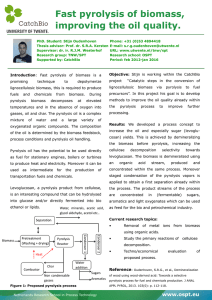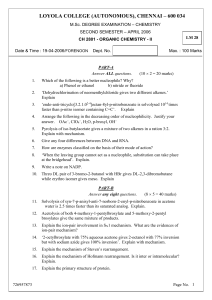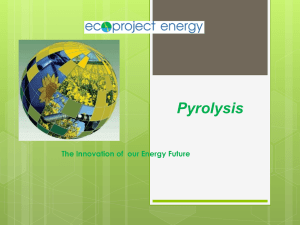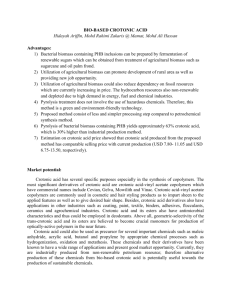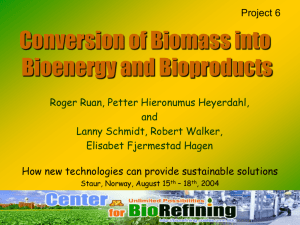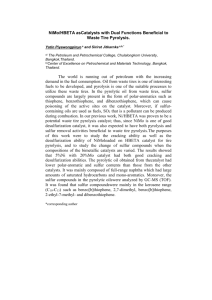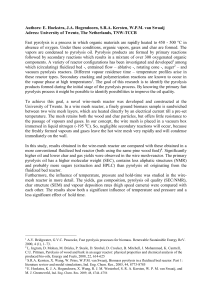Processes, Biofuels, and - Biological Systems Engineering
advertisement
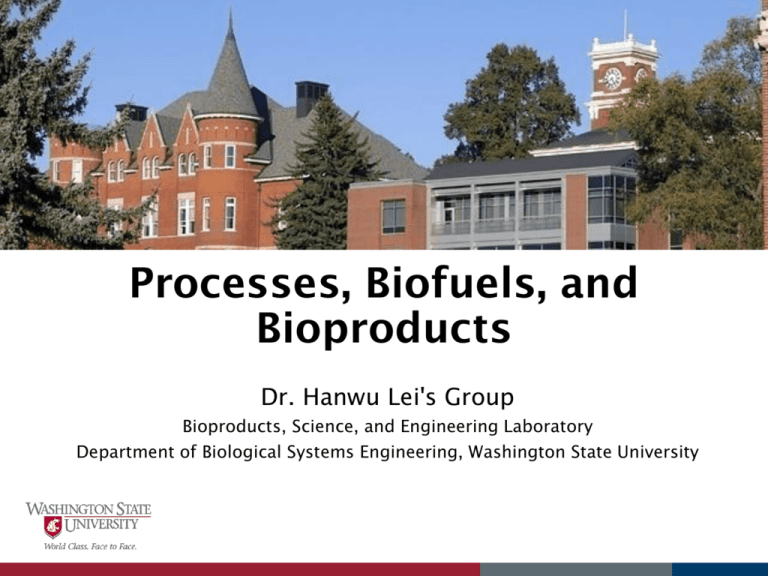
Processes, Biofuels, and Bioproducts Dr. Hanwu Lei's Group Bioproducts, Science, and Engineering Laboratory Department of Biological Systems Engineering, Washington State University Outline Dr. Hanwu Lei’s research group Processes: torrefaction, pyrolysis, catalysis, liquid-liquid extraction, organosolv liquefaction, hot-water pretreatment, organosolv fractionation, CO2 removal and absorption, and fuel process kinetics Biofuels: bio-oil, hydrocarbons, aromatics, hydrogen, biojet fuel, bio-gasoline, biodiesel, fuel ethanol Chemicals: bio-phenols, bio-aromatics, bio-polyols Bioproducts: biochar, carbon catalyst, activated carbon, carbon catalyst, carbon absorber, polyurethane foam (PUF), water resistant wood adhesive Dr. Hanwu Lei’s Group Post-Doc Research Associate: Lu Wang, PhD. Working on catalysis for jet fuels Post-MS Research Associate: Di Yan, MS. Working on microwave pyrolysis Gayatri Yadavalli, MS. Working on microwave pyrolysis, CO2 removal, protein extraction Current Graduate Students: Lei Zhu, PhD Research Assistant, Department of Biological Systems Engineering, WSU; PhD dissertation: Development of processes and catalysts for aviation biofuels production (in progress) Xuesong Zhang, PhD Research Assistant, Department of Biological Systems Engineering, WSU; PhD dissertation: Upgrading bio-oils from Douglas fir pellets with packed-bed catalysis over catalysts coupled with microwave-assisted pyrolysis (in progress) Charles Shaw, PhD Research Assistant, Environmental Science, WSU, PhD thesis: Life-cycle-analysis of microwave pyrolysis of hybrid poplar for the production of biofuels and biochar (in progress) Yupeng Liu, MS Research Assistant, Department of Biological Systems Engineering, WSU; MS thesis: Torrefaction of Douglas fir pellets and its upgrading (in progress) Dr. Hanwu Lei’s Group Graduated PhD Students (6): Yi Wei, PhD, Department of Biological Systems Engineering, WSU (Research Assistant from Aug. 2011-Aug. 2015); PhD dissertation: Advanced upgrading of pyrolysis oil via liquidliquid extraction and catalytically upgrading (Graduated Spring 2015) Quan Bu, PhD, Department of Biological Systems Engineering, WSU (Research Assistant from Aug. 2010-Aug. 2013; Now Associate Professor at Jiangsu University); PhD dissertation: Catalytic microwave pyrolysis of biomass for renewable phenols and fuels (Graduated Summer 2013). Lu Wang, PhD, Department of Biological Systems Engineering, WSU (Research Assistant from Aug. 2010-Aug. 2013; Now post-doc at Washington State University); PhD dissertation: Aromatic hydrocarbons production from catalyst assisted microwave pyrolysis of Douglas fir sawdust pellet (Graduated Summer 2013). Shoujie Ren, PhD, Department of Biological Systems Engineering, WSU (Research Assistant from Jan. 2010-Dec. 2012; Now post-doc at University of Tennessee); PhD dissertation: Catalytic microwave torrefaction and pyrolysis of Douglas fir pellet to improve biofuel quality (Graduated Fall 2012). Iwona Cybulska, PhD, Department of Biological and Agricultural Engineering, SDSU (Research Assistant from Jan. 2008-May. 2012; Now post-doc at Masdar Institute of Science and Technology); PhD dissertation: Pretreatment methods for lignocellulosic materials employed to produce fuel ethanol and value-added products (Graduated Spring 2012). Rui Zhou, PhD, Department of Biological and Agricultural Engineering, SDSU (Research Assistant from Jan. 2008-Dec. 2014); PhD dissertation: Microwave pyrolysis of biomass and kinetics (Graduated Spring 2015). Dr. Hanwu Lei’s Group Graduated MS Students (2): Gayatri Yadavalli, MS student, Environmental Engineering, WSU (Aug. 2013-Dec. 2014); MS dissertation: activated carbon surface modification for carbon dioxide adsorption (Graduated Fall 2014) Jing Liang, MS, Department of Biological Systems Engineering, WSU (Research Assistant from Aug. 2011-Aug. 2013; Now PhD student at University of California, Riverside); MS project title: Tech-economic analysis of microwave pyrolysis of Douglas fir pellet (Graduated Summer 2013) Biomass Pyrolysis Conventional Pyrolysis: Biomass has to be dried before fast/flash pyrolysis Biomass Bio-gas Size reduction required <1mm Drying Fast/Flash Pyrolysis Bio-oil Bio-char Microwave Pyrolysis: Biomass Wet biomass can be used Bio-gas Size reduction Not Required Microwave Pyrolysis Bio-oil Bio-char Energy Consumed in Size Reduction Microwave: No energy required as size not important. Demonstrated on 4 mm pellets, 7x15mm2 wood blocks, and 1x0.6x0.6m3 stover bales (Lei et al, 2009; Moen et al., 2009; Zhao et al., 2011) Conventional: > 1600 kJ/kg biomass for <1mm particles Demonstrated on fluidized bed pyrolysis on particles <0.5 mm (Yi et al., 2008; Boateng et al., 2007; Luo et al., 2005) Miao et al., 2011 Energy Consumed in Drying Microwave: No energy required before pyrolysis! Do NOT require biomass (8-20%MC) drying before pyrolysis stage Conventional: 2940 to 5538 kJ/kg of water Requires biomass (8-20% MC) drying before pyrolysis Energy required to evaporate water and increase temperature of both water and biomass. • Moreno et al., 2007; Hailer 1993; Snezhkin et al., 1997; Vanecek et al 1996; Moreno and Rios 2002; Renstrom and Berghel 2002 Microwave vs Conventional: Energy Comparison Microwave pyrolysis Conventional pyrolysis Biomass size reduction 0 kJ/kg Biomass size reduction (1mm) 1600 kJ/kg Drying and raising temp to 177°C 55.56+666.67 =722.23 kJ/kg (wet) Drying required to provide energy at 80% efficiency raising to 140°C 561.53 kJ/kg (wet) Raising temp of dried biomass to 500°C 777.78 kJ/ 0.92 kg (dry) Raising temp of dry biomass to 500°C at 90% efficiency 1116.78 kJ/ 0.92 kg (dry) Maintaining temp and pyrolysis 311.11 kJ/ 0.92 kg (dry) Maintaining temp and pyrolysis Up to 3064 kJ/kg (literature) kJ/ 0.92 kg (dry) Total (1 kg wet biomass with 8% water content) 1811.11 kJ/kg (wet) Total (1 kg wet biomass with 8% water content) 3278.31 kJ/kg (wet) Conclusion: 1. Microwave pyrolysis consumes 504 kwh per ton of wet biomass 2. Conventional pyrolysis estimated to consume >910 kwh per ton of wet biomass Microwave pyrolysis does not require energy for size reduction and uses less in pyrolysis. ***Larger scale microwave pyrolysis requires less energy: University of Nottingham microwave pyrolysis pilot scale (250kg/hr) energy requirement: 230 kWh per tonne. Mass / energy balances of microwave pyrolysis for Douglas fir pellets Mass In Douglas fir pellets (kg) 1,000 Mass Out Syngas (scf) Bio oil (kg) Bio Char (kg) 4,073 550 300 Bio-oil yield is about 60% based on dry Douglas fir pellets Energy In Unit Btu Sub-total Btu Douglas fir pellets 17,621 (Btu/kg) Electricity Energy Out Syngas 3340 335 (Btu/scf) (Btu/kwh) 540*3340kwh 17,621,000 1,364,589 =1,804,012 Bio oil Bio Char 17,061 (Btu/kg) 28,435 (Btu/kg) 9,383,388 8,530,353 Supply biochar for a coal-firing plant: 35% efficiency to electricity and 90% transmission efficiency to microwave pyrolysis plant =8,530,353*35%*90%=2,687,061 BTU More than 150% electricity can be supplied from biochar firing Microwave Pyrolysis S. Ren, H. Lei*, L. Wang, Q. Bu, S. Chen, J. Wu, J. Julson, and R. Ruan. 2012. Biofuel production and kinetics analysis of microwave pyrolysis for Douglas fir sawdust pellet. Journal of Analytic and Applied Pyrolysis, 94: 163-169. doi: 10.1016/j.jaap.2011.12.004. H. Lei*, S. Ren, L. Wang, Q. Bu, J. Julson, J. Holladay, and R. Ruan. 2011. Microwave pyrolysis of distillers dried grain with solubles (DDGS) for biofuel production. Bioresource Technology, 102 (10) 6208-6213, doi:10.1016/j.biortech.2011.02.050 H. Lei*, S. Ren, and J. Julson. 2009. The effects of reaction temperature and time and particle size of corn stover on microwave pyrolysis. Energy and Fuels, 23, 3254-3261. Biomass Torrefaction to Torrefied Biomass Torrefaction: 200–300℃ in absence of oxygen 70-90% yield torrefied biomass Yang H. et al., Characteristics of hemicellulose, cellulose and lignin pyrolysis. Fuel, 2007, 86: 1781–1788 Water is reduced Hemicellulose is decomposed, cellulose and lignin are partial decomposed O/C ratio is decreased Heating value is increased Tumuluru J.S. et al., A review on biomass torrefaction process and product properties for energy applications. Industrial Biotechnology, 2011, 7: 384-401. Microwave Torrefaction shoulder H. Lei* and S. Ren. 2010. Filed patent (US 61404560), Method and apparatus for biomass torrefaction and pyrolysis. S. Ren, H. Lei*, L. Wang, Q. Bu, S. Chen, J. Wu. 2013. Thermal behavior and kinetic study for woody biomass torrefaction and torrefied biomass pyrolysis by TGA. Biosystems Engineering, 116, 4, 420-426. doi: 10.1016/j.biosystemseng.2013.10.003. S. Ren, H. Lei*, L. Wang, Q. Bu, S. Chen, J. Wu, J. Julson, and R. Ruan. 2013. The effects of torrefaction on compositions of biooil and syngas from biomass pyrolysis by microwave heating. Bioresource Technology, 135, 659-994. doi: 10.1016/j.biortech.2012.06.091. S. Ren, H. Lei*, L. Wang, Q. Bu, Y. Wei, J. Liang, Y. Liu, J. Julson, S. Chen, J. Wu, and R. Ruan. 2012. Microwave torrefaction of Douglas fir sawdust pellet. Energy & Fuels, 26, 5936-5943. doi: 10.1021/ef300633c. Torrefied Biomass Pyrolysis Cellulose + furans Torrefied biomass Char + gases + char gases Lignin O-CH3 homolysis hydrogenation + Phenol, 2-methoxy-4-methyl- 1,2-Benzenediol catalysis CH4 Overview Processes in Dr. Lei’s Group Organosolv fractionation Lignocellulosic biomass Torrefaction Hydrothermal/hot water pretreatment Syngas Microwave pyrolysis Activated carbon Char Carbon catalysts Pyrolysis bio-oil Purification/separation Substitute of petroleum-based phenols as for chemical industry (i.e. phenol formaldehyde resin, bio-plastics) Catalysis/Catalytic upgrading Biofuels (i.e. gasoline, jet fuel) Chemical feedstocks (i.e. aromatics, phenols) Aromatics Cellulose Hemicelluloses Dehydration Depolymerization DF Catalyst assisted dehydration Ethers, Alcohols, Ketones, Aldehydes Decarboxylation Decarbonylation Oligimerization Lignin Depolymerization Zeolite assisted demethoxylation Zeolite Catalysis Aromatics from Biomass H. Lei* and L. Wang. 2014. Filed patent (USPTO 61938416). Aromatic hydrocarbons from lignocellulose biomass. L. Wang, H. Lei*, Q. Bu, L. Zhu, Y. Wei, X. Zhang, Y. Liu, G. Yadavalli, J. Lee, S. Chen, and J. Tang. 2014. Aromatic hydrocarbons production from ex-situ catalysis of pyrolysis vapor over Zinc modified ZSM-5 in a packed-bed catalysis coupled with microwave pyrolysis reactor. Fuel. Under review. L. Wang, H. Lei*, J. Lee, S. Chen, J. Tang, B. Ahring. 2013. Aromatic hydrocarbons from packed-bed catalysis coupled with microwave pyrolysis of Douglas fir sawdust pellets. RSC Advances, 34, 3, 14609 – 14615. doi: 10.1039/C3RA23104F. Z. Du, X. Ma, Y. Li, P. Chen, Y. Liu, X. Lin, H. Lei, R. Ruan. 2013. Production of aromatic hydrocarbons by catalytic pyrolysis of microalgae with zeolites: Catalyst screening in a pyroprobe. Bioresource Technology, 139, 397-401 doi: 10.1016/j.biortech.2013.04.053 L. Wang, H. Lei*, S. Ren, Q. Bu, J. Liang, Y. Wei, Y. Liu, G. J. Lee, S. Chen, J. Tang, Q. Zhang, and R. Ruan. 2012. Aromatics and phenols from catalytic pyrolysis of Douglas fir pellets in microwave with ZSM-5 as a catalyst. Journal of Analytic and Applied Pyrolysis, 98, 194-200. doi: 10.1016/j.jaap.2012.08.002. Aromatics from Waste Plastics R2 R2 n H 2C CH A n H 2C CH2 CH n H 2C CH2 R1 R1 HC CH2 CH CH CH CH2 R1 + R2 n R LDPE n HC n H2C CH R CH2 R R R R H2C H2 CH CH R CH2 + H2 X. Zhang, H. Lei**, G. Yadavalli, L. Zhu, Y. Wei, Y. Liu. 2015. Gasoline-range Hydrocarbons produced from Microwave-induced Pyrolysis of Low-Density Polyethylene over ZSM-5. Fuel, 144: 33-42. doi: 10.1016/j.fuel.2014.12.013. Aromatics Aromatic hydrocarbons are the most desired products to increase fuel octane number and decrease the tendency of engine knock and damage. Aromatics cause elastomeric seals swell and increase the fuel density to meet the minimum requirement in jet fuels. Jet fuels without aromatics will cause some of these elastomers to shrink, which may lead to fuel leaks. Aromatics in chemical refined petroleum fuels Component (v %) Crude oil Fuel Oil #6 Saturates Aromatics 58-61 33-36 21.1 78.9 Diesel Fuel Marine (DFM) 12 88 Jet fuels 75% 25% Naval Distillate Fuels, F-76 45.8-69.0 29.0-53.8 Brazil US Gasoline Gasoline 38 62 28.7 71.3 Kuwait Gasoline Russia Gasoline 14.4 85.6 34.5 65.5 Data derived from NIPER Report 1989 by National Institute for Petroleum and Energy Research (NIPER-428); DFM and F-76 data derived from National Academy of Sciences. US gas data from CA based Guided Wave, Inc.; other countries' data from Faruq et al., 2012. Jet fuels X. Zhang, H. Lei**, L. Wang, L. Zhu, Y. Wei, Y. Liu, G. Yadavalli, D Yan, J. Wu, S. Chen. 2015. Insight in the integrated catalytic processes of intact biomass for production of renewable jet fuel range paraffins and aromatics. Bioresource Technology. Under review Project: Hydrogen saving process for cycloalkanes (naphthenes) in jet fuels from diverse Washington state forest biomasses. Joint Center for Aerospace Technology and Innovation, Joint Industry-University Research Program. (awarded 07/01/2014-06/30/2015) Opportunity for Utilizing Lignin General near-term opportunities (power, fuel and syngas) Generally medium-term opportunities (macromolecules such as phenols (more than 95% of phenol used is derived from petroleum based benzene by cumene process)) Long-term opportunities (aromatics and other monomers) Possible lignin transformation technologies Holladay et al., 2007 Lignin-to-phenols Mechanism C + H2O CH4 + H2O CO + H2O CH3 H 3C γ OH lignin β 2 5 3 4 Hydrogenolysis,HDO Decarboxylation, DME, DMO CH3 α SH 1 6 H3C OH3C CO + H2 >400°C Low temperature Intermediate(Polyaromatics) Volatile + Char β-O-4 ,C-C cleavage H (or lignin) OH The high concentrations of bio-phenols were probably generated by the free radical reaction of O–CH homolysis where cellulose-derived volatiles and lignin-derived products function as H-donations and H acceptors, respectively. GC/MS Analysis of Phenols Enriched Bio-oils Chemical composition by GC/MS analysis(%) 100 90 Acids 80 Sugars 70 Ketones/aldehy des Guaiacols 60 Phenols 50 Hydrocarbons 40 Alcohols 30 Furans 20 Ester 10 Others 0 MRX DARCO- 1240PLUS GAC830 830 PLUS No AC The phenols content of bio-oils was 74.61%, 73.88% for MRX and DARCO 830, respectively vs. 2.5% of control. The guaiacols content was 1.5% and 0% for MRX and DARCO 830, respectively vs. 52% of control. Bio-phenols OH OH OCH3 OCH3 decarbonylation dealkylation DME DMO alkylation R R: H, CH3, CHO, C2H5 OH OH OH OH OH H. Lei*, Q. Bu, S. Ren, and L. Wang. 2011. Filed patent (USPTO 61483132). Microwave Assisted Pyrolysis and Phenol Recovery. Q. Bu, H. Lei*, L. Wang, Y. Wei, L. Zhu, L. Zhu, X. Zhang, Y. Liu, G. Yadavalli and J. Tang. 2014. Bio-based phenols and fuel production from catalytic microwave pyrolysis of lignin by activated carbons. Bioresource Technology. Under review Q. Bu, H. Lei*, L. Wang, Y. Liu, J. Liang, Y. Wei, L. Zhu, and J. Tang. 2013. Renewable phenols production by catalytic microwave pyrolysis of Douglas fir sawdust pellets with activated carbon catalysts. Bioresource Technology, 142: 546-552. doi: 10.1016/j.biortech.2013.05.073. Q. Bu, H. Lei*, A. H. Zacher, L. Wang, S. Ren, J. Liang, Y. Wei, Y. Liu, J. Tang, Q. Zhang, and R. Ruan. 2012. A review of catalytic hydrodeoxygenation of lignin-derived phenols from biomass pyrolysis. Bioresource Technology, 124, 470-477. doi: 10.1016/j.biortech.2012.08.089. 07.10.12 Q. Bu, H. Lei*, S. Ren, L. Wang, Q. Zhang, J. Tang, and R. Ruan. 2012. Production of phenols and biofuels by catalytic microwave pyrolysis of lignocellulosic biomass. Bioresource Technology, 108: 274-279. doi: 10.1016/j.biortech.2011.12.125. Q. Bu, H. Lei*, S. Ren, L. Wang, J. Holladay, Q. Zhang, J. Tang, and R. Ruan. 2011. Phenol and phenolics from lignocellulosic biomass by catalytic microwave pyrolysis. Bioresource Technology, 102: 7004-7007. doi:10.1016/j.biortech.2011.04.025 Phenols Phenolic Resins • Phenol and its derivatives are vital industrial chemical compounds found in myriad industrial products mainly produced from petroleum. • The phenol price is $1,609-1,649/ton CFR (cost and freight) according to ICIS Pricing Report (Feb. 2014). • Current phenol production volumes amount to 8 million tonnes per year and the phenol market is expected to grow at a compound annual growth rate of 3.9% over the next 10 years. • The phenol and its derivatives are currently used for chemical industry, and its main applications—phenolic resins, plastics, and caprolactam—achieve costs in the region of $1,870 to $3,120 per N. Smolarski. 2012 tonne. Hydrogen and High Quality Syngas Y. Wei, H. Lei*, Y. Liu, L. Wang, L. Zhu, X. Zhang, G. Yadavalli, B. Ahring, S. Chen. 2014. Renewable hydrogen produced from different renewable feedstocks by aqueous-phase reforming process. Journal of Sustainable Bioenergy Systems. In press. S. Ren, H. Lei*, L. Wang, Q. Bu, S. Chen, J. Wu. 2014. Hydrocarbons and hydrogen-rich syngas production by biomass catalytic pyrolysis and bio-oil upgrading over biochar catalysts. RSC Advances, 4 (21), 10731 – 10737. doi: 10.1039/c4ra00122b. Catalysis: Zeolite Catalysts L. Wang, H. Lei*, Q. Bu, L. Zhu, Y. Wei, X. Zhang, Y. Liu, G. Yadavalli, J. Lee, S. Chen, and J. Tang. 2014. Aromatic hydrocarbons production from ex-situ catalysis of pyrolysis vapor over Zinc modified ZSM-5 in a packed-bed catalysis coupled with microwave pyrolysis reactor. Fuel. Under review. L. Wang, H. Lei*, J. Lee, S. Chen, J. Tang, B. Ahring. 2013. Aromatic hydrocarbons from packed-bed catalysis coupled with microwave pyrolysis of Douglas fir sawdust pellets. RSC Advances, 34, 3, 14609 – 14615. doi: 10.1039/C3RA23104F. Z. Du, X. Ma, Y. Li, P. Chen, Y. Liu, X. Lin, H. Lei, R. Ruan. 2013. Production of aromatic hydrocarbons by catalytic pyrolysis of microalgae with zeolites: Catalyst screening in a pyroprobe. Bioresource Technology, 139, 397-401 doi: 10.1016/j.biortech.2013.04.053 L. Wang, H. Lei*, S. Ren, Q. Bu, J. Liang, Y. Wei, Y. Liu, G. J. Lee, S. Chen, J. Tang, Q. Zhang, and R. Ruan. 2012. Aromatics and phenols from catalytic pyrolysis of Douglas fir pellets in microwave with ZSM-5 as a catalyst. Journal of Analytic and Applied Pyrolysis, 98, 194-200. doi: 10.1016/j.jaap.2012.08.002. Z. Du, B. Hu, X. Ma, Y. Cheng, Y. Liu, X. Lin, Y. Wan, H. Lei, P. Chen, and R. Ruan*. 2013. Catalytic pyrolysis of microalgae and their three major components: carbohydrates, proteins, and lipids. Bioresource Technology, 130: 777–782. doi: 10.1016/j.biortech.2012.12.115 Catalysis: Biochar Catalysts and Biomass Derived Carbon Catalysts S. Ren, H. Lei**, L. Wang, Q. Bu, S. Chen, J. Wu. 2014. Hydrocarbons and hydrogen-rich syngas production by biomass catalytic pyrolysis and bio-oil upgrading over biochar catalysts. RSC Advances, 4 (21), 10731 – 10737. doi: 10.1039/c4ra00122b. L. Zhu, H. Lei*, L. Wang, X. Zhang, Y. Wei, Y Liu, G. Yadavalli. Characterization of surface functional groups in corn stover biochar derived from microwaveassisted pyrolysis. 2014 ASABE International Meeting, Jul 13-16, 2014, Montreal, QC, Canada. L. Zhu, H. Lei*, L. Wang, Q. Bu, Y. Wei, Y. Liu, and J. Liang. 2013. Carbon catalyst from corn stover and its application to catalytic microwave pyrolysis. American Society of Agricultural and Biological Engineers (ASABE) 2013 Annual International Meeting, 2013(3): 1854-1860. doi: http://dx.doi.org/10.13031/aim.20131594788. L. Zhu, H. Lei*, L. Wang, Q. Bu, J. Liang, Y. Wei, Y. Liu. Catalytic Microwave Pyrolysis of Douglas Fir Pellets With Carbon Catalysts Derived From Corn Stover. 2013 AIChE Annual Meeting, San Francisco, California, November 3 – 8, 2013. Catalysis: Activated Carbon Catalysts Q. Bu, H. Lei**, L. Wang, Y. Liu, J. Liang, Y. Wei, L. Zhu, and J. Tang. 2013. Renewable phenols production by catalytic microwave pyrolysis of Douglas fir sawdust pellets with activated carbon catalysts. Bioresource Technology, 142: 546-552. doi: 10.1016/j.biortech.2013.05.073. Q. Bu, H. Lei**, L. Wang, Y. Liu, J. Liang, Y. Wei, L. Zhu, and J. Tang. 2013. Renewable phenols production by catalytic microwave pyrolysis of Douglas fir sawdust pellets with activated carbon catalysts. Bioresource Technology, 142: 546-552. doi: 10.1016/j.biortech.2013.05.073. Q. Bu, H. Lei**, L. Wang, Y. Wei, L. Zhu, L. Zhu, X. Zhang, Y. Liu, G. Yadavalli and J. Tang. 2014. Bio-based phenols and fuel production from catalytic microwave pyrolysis of lignin by activated carbons. Bioresource Technology. Under review. CO2 Removal 1 0.8 0.6 C/C0 CM1 CM2 0.4 CM3 0.2 0 0 2 4 6 8 10 Minutes 12 14 16 18 Dr. Lei’s group developed a carbon which selectively removed >97 % carbon dioxide from a mixed gas stream containing methane, carbon dioxide, carbon monoxide, nitrogen and hydrogen. Biochar for Crop Management, Herbicide Absorbents, and Control of Weeds D. D. Malo, S. A. Clay*, T.E. Schumacher, H. J. Woodard, D. E. Clay, R. H. Gelderman, H. Lei and J. L. Julson. Interactions of biochar source/properties impacts on soil properties, c sequestration potential, and crop management. In 2010 SunGrant Annual Meeting, Reno, NV. Dr. Lei's biochar was used by Drs. Clay and Malo for herbicide sorption studies: Clay, S.A. and D.D. Malo. 2012. The Influence of Biochar Production on Herbicide Sorption Characteristics, Herbicides - Properties, Synthesis and Control of Weeds, M. N. A. E. Hasaneen (Ed.), InTech, ISBN: 978-953-307-803-8. http://www.intechopen.com/articles/show/title/theinfluence-of-biochar-production-on-herbicide-sorption-characteristics. Liquid-Liquid Extraction Liquid-liquid extraction was used to extract the phenols and guaiacols from water phase: Chloroform solvent has a better results than the other two solvents on liquid-liquid extraction for selecting phenols and guaiacols. When under 1:1 solvent to water-phase ratio, using chloroform as extraction solvent, the organic concentration reached to 85% of total phenol and guaiacols compounds in water-phase of bio-oil. Through liquid-liquid extraction, sugar and acid can be completely removed from mixture and stayed in the water phase. Y. Wei, H. Lei*, L. Wang, L. Zhu, X. Zhang, Y. Liu, S. Chen, B. Ahring. 2014. Liquid-liquid extraction of biomass pyrolysis bio-oil. Energy and Fuels, 28(2), 1207-1212. doi: 10.1021/ef402490s. C. Yang, B. Zhang, J. Moen, K. Hennessy, Y. Liu, X. Lin, Y. Wan, H. Lei*, P. Chen, and R. Ruan*. 2010. Fractionation and characterization of bio-oil from microwave-assisted pyrolysis of corn stover. International Journal of Agricultural and Biological Engineering, 3(3): 54-61. Organosolv Liquefaction Bio-Polyurethane Foam (PUF) and Bio-Adhesives L. Gao, Y. Liu, H. Lei*, H. Peng, R. Ruan*. 2010. Preparation of semirigid polyurethane foam with liquefied bamboo residues. Journal of Applied Polymer Science, 116, 1694-1699. Y. Wang, J. Wu, Y. Wan, H. Lei*, F. Yu, P. Chen, X. Lin, and R. Ruan*. 2009. Liquefaction of corn stover using industrial biodiesel glycerol. International Journal of Agricultural and Biological Engineering, 2(2): 32-40. Polyurethane foam Adhesive Hydrothermal/Hot Water Pretreatment I. Cybulska, G. Brudecki, H. Lei*. 2013. Hydrothermal pretreatment of lignocellulosic biomass. In Green Biomass Pretreatment and Processing Methods for Bioenergy Production. Ed. T. Gu. Springer. ISBN: 978-94-007-6052-3. pp 87-106. doi: 10.1007/978-94-007-6052-3_4. I. Cybulska, G. Brudecki, H. Lei*, J. Julson. 2012. Optimization of combined clean fractionation and hydrothermal post-treatment of prairie cord grass. Energy & Fuels, 26(4): 2303-2309. doi: 10.1021/ef300249m I. Cybulska, H. Lei*, J. Julson. 2010. Hydrothermal pretreatment and enzymatic hydrolysis of prairie cord grass. Energy & Fuels, 24 (1): 718-727. Organosolv Fractionation/Separation of Biomass: Organic phase Organic phase Aqueous phase Aqueous phase Lignin precipitated Cellulose after clean fractionation I. Cybulska*, G. P. Brudecki, B. R. Hankerson, J. L. Julson, H. Lei. 2013. Catalyzed modified clean fractionation of switchgrass. Bioresource Technology, 127, 92-99. doi: 10.1016/j.biortech.2012.09.131. 03.08.12 I. Cybulska*, G. Brudecki, K. Rosentrater, J. Julson, H. Lei. 2012. Comparative study of organosolv lignins extracted from prairie cordgrass, switchgrass and corn stover. Bioresource Technology, 118C: 30-36. doi: 10.1016/j.biortech.2012.05.073. I. Cybulska*, G. Brudecki, K. Rosentrater, H. Lei, J. Julson. 2012. Catalyzed modified clean fractionation of prairie cordgrass integrated with hydrothermal post-treatment. Biomass and Bioenergy, 46, 389-401. doi: 10.1016/j.biombioe.2012.08.002. I. Cybulska, H. Lei*, J. Julson, G. Brudecki. 2012. Optimization of Modified Clean Fractionation of Prairie Cord Grass. International Journal of Agricultural and Biological Engineering, 5(2): 42-51. doi: 10.3965/j.ijabe.20120502.00? Canola Oil/Protein Extraction Pressing Solvent extraction/ Expeller pressing K. Zhong (PI), H. Lei (Co-PI), L. Scudiero, T. Marsh, P. Tozer, Applying Abundant Plants to Develop Battery Materials and Study the Benefits on Agricultural Economy. USDA, $494,805, 12/11/2014-12/31/2017 Fuel Process Kinetics S. Ren, H. Lei*, L. Wang, Q. Bu, S. Chen, J. Wu. 2013. Thermal behavior and kinetic study for woody biomass torrefaction and torrefied biomass pyrolysis by TGA. Biosystems Engineering, 116, 4, 420-426. doi: 10.1016/j.biosystemseng.2013.10.003. H. Lei*, I. Cybulska, J. Julson. 2013. Hydrothermal pretreatment of lignocellulosic biomass and kinetics. Journal of Sustainable Bioenergy Systems, 3(4): 250-259. doi: 10.4236/jsbs.2013.34034. R. Zhou, H. Lei*, J. Julson. 2013. Reaction temperature and time and particle size on switchgrass microwave pyrolysis and reaction kinetics. International Journal of Agricultural and Biological Engineering, 6(1): 5361. dio: 10.3965/j.ijabe.20130601.005. R. Zhou, H. Lei*, J. Julson. 2013. The Effects of pyrolytic conditions on microwave pyrolysis of prairie cordgrass and kinetics. Journal of Analytic and Applied Pyrolysis, 101, 172-176. doi: 10.1016/j.jaap.2013.01.013. Acknowledgements My research group members: Dr. Quan Bu, Dr. Iwona Cybulska, Dr. Shoujie Ren, Dr. Lu Wang, Dr. Yi Wei, Dr. Rui Zhou, and Ms. Jing Liang, Mr. Yupeng Liu, Ms. Gayatri Yadavalli, Ms. Di Yan, Mr. Xuesong Zhang, Mr. Lei Zhu, Mr. Charles Shaw Collaborators: Dr. John Holladay, Dr. Rick Orth, Mr. Doug Elliott, Mr. Alan Zacher, Dr. Ayman Karim, Dr. John Lee, Dr. James Julson, Dr. Katie Zhong, Dr. Roger Ruan, Dr. Gary Fulcher, and many others. Thank you! prairieecothrifter.com

